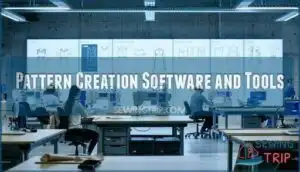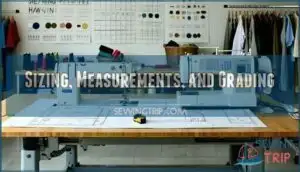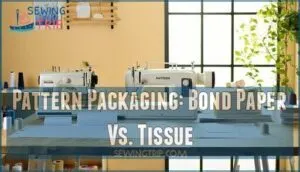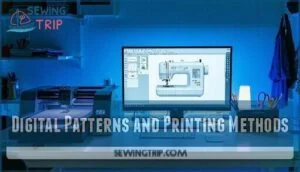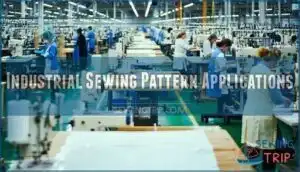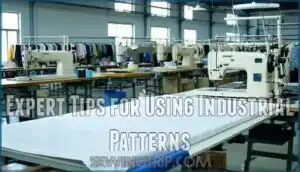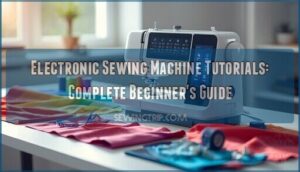This site is supported by our readers. We may earn a commission, at no cost to you, if you purchase through links.
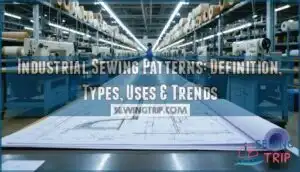
Industrial sewing patterns are the backbone of mass production, engineered with technical specifications that eliminate guesswork and guarantee every piece fits identically. These patterns incorporate grading charts, seam allowances, and construction markers that transform raw fabric into uniform products at scale.
From airbags to hospital gowns, the difference between amateur and industrial patterns isn’t just quality—it’s the ability to replicate excellence ten thousand times over.
Table Of Contents
Key Takeaways
- Industrial sewing patterns are precision blueprints engineered for mass production, eliminating guesswork through technical specifications like grading charts and seam allowances that guarantee identical fits across thousands of units.
- The market is experiencing explosive growth, with the industrial sewing machine sector projected to reach $5.4 billion by 2034, driven by AI-powered pattern generation achieving 95% accuracy and cutting prototype time by 70%.
- These patterns extend far beyond clothing into life-critical applications like automotive airbags, aerospace parachutes, and medical textiles, proving that precision stitching determines survival in high-stakes industries.
- Digital pattern technology has revolutionized production workflows by enabling instant downloads, automated grading across size ranges, and pattern optimization algorithms that minimize fabric waste while maintaining consistent quality control.
What Are Industrial Sewing Patterns?
Industrial sewing patterns are the blueprint behind mass production in textile manufacturing. They’re built for speed, precision, and consistency across thousands of units.
Let’s break down what makes them tick, how they evolved, and where you’ll find them in action.
Definition and Key Features
Industrial sewing patterns are the blueprints that turn raw fabric into finished products—think of them as the DNA of everything from your favorite jeans to the airbag in your car. These pattern design templates include precise measurement tools, fabric selection guides, and garment construction details.
Unlike basic sewing patterns, they’re built for speed, accuracy, and repeatability. Digital sewing patterns simplify pattern making, letting you scale production while maintaining a consistent fit across thousands of units.
How Industrial Patterns Differ From Home Patterns
While home patterns might forgive a wobbly seam or an extra inch here and there, industrial patterns demand flawlessness. They’re engineered to manage hundreds or thousands of identical pieces rolling off the line every single day.
Industrial sewing techniques rely on standardized measurement tools and precise fabric choice calculations. Digital sewing patterns guarantee production efficiency through consistent garment construction, while pattern making at this scale eliminates guesswork—every notch, grainline, and seam allowance fulfills a purpose in streamlining your workflow.
History and Evolution of Industrial Patterns
That impeccable precision you see today didn’t spring from thin air. Pattern origins trace back centuries before machines took over. Then the Industrial Revolution flipped textile history on its head, driving manufacturing evolution through steam-powered looms and faster production lines. Here’s how sewing innovations reshaped pattern making:
- Early drafting systems standardized garment construction measurements in the 1800s
- Industrial sewing techniques emerged alongside factory-scale textile manufacturing
- Grading methods allowed one design to scale across multiple sizes efficiently
- Paper patterns replaced hand-drawn templates, boosting fabric manipulation accuracy
- Digital tools now merge fashion design principles with apparel production speed
The development of industrial pattern making relies heavily on pattern making processes to create high-quality garments. You’ve moved from artisan guesswork to engineered consistency—and that’s the backbone of modern manufacturing.
Common Pattern Types and Uses
Once you’ve nailed the evolution, it’s time to pick the right pattern type for the job—because not every design works the same way across apparel, automotive, or medical textiles.
Clothing patterns manage garment construction for everyday wear, while digital sewing patterns simplify fabric selection and industrial sewing techniques for mass production.
Pattern design conforms to textile science demands—seat covers need different weaving than hospital gowns, and that’s where garment construction and pattern making expertise separates pros from hobbyists.
How Industrial Sewing Patterns Are Made
Creating industrial sewing patterns isn’t guesswork—it’s a precise craft that blends technology with technique. From digital design tools to final packaging, each step ensures patterns translate into consistent, production-ready results.
Let’s break down the process that takes an idea from screen to factory floor.
Pattern Creation Software and Tools
Think of pattern creation software as your digital drafting table on steroids. Modern tools transform how you design and produce. Here’s what’s revolutionizing the floor:
- Digital drafting platforms let you sketch and perfect patterns with precision you can’t match by hand.
- Automated grading systems scale sizes instantly, cutting hours of manual work.
- Pattern optimization algorithms minimize fabric waste and boost efficiency.
- Design collaboration features connect your team in real-time, wherever they are.
- PDF patterns and digital sewing pattern exports simplify production from screen to machine.
Software integration means faster turnarounds and tighter quality control. Pattern making has never been this powerful. The use of pattern making software improves the overall design process.
Sizing, Measurements, and Grading
Getting the right size down cold is where industrial patterns separate the pros from the amateurs. You’ll rely on precise Body Measurements and standardized Size Charts to nail every fit. Grading Rules let you scale one pattern across multiple sizes seamlessly. Here’s your sizing framework:
| Element | Purpose | Impact |
|---|---|---|
| Body Measurements | Captures key dimensions (bust, waist, hip) | Ensures accurate baseline fit |
| Size Charts | Maps measurements to standard sizes (8-26, 34-54) | Simplifies ordering and production |
| Grading Rules | Defines size increments between grades | Maintains proportional fit across range |
| Fit Analysis | Tests pattern against target body types | Reduces costly alterations |
| Measurement Standards | Establishes industry-wide consistency | Streamlines multi-location manufacturing |
When you master Graded Pattern techniques and lock down your sizing charts, you’re controlling quality at scale.
Pattern Packaging: Bond Paper Vs. Tissue
Your packaging choice between Bond Paper and Tissue isn’t just about preference—it’s about controlling your production timeline and workflow rhythm. Bond Paper patterns ship in three to seven days since they’re printed in-house to order, while Tissue patterns fly out immediately—they’re pre-printed off-site.
Paper Quality differs too: bond offers sturdier durability for repeated use, tissue wins on cost and storage. Weigh Shipping Times against your project deadline.
Digital Patterns and Printing Methods
Modern digital patterns eliminate the wait-and-wonder game—you download, print on demand, and start cutting within minutes. Pattern software and inkjet technology power this shift, while laser cutting and 3D modeling push precision further.
How to print PDF sewing patterns efficiently:
- Download your digital sewing pattern as a PDF instantly
- Use digital printing at home or send files to industrial printers
- Verify scale with test squares before full-sheet output
- Archive PDFs digitally—no storage space wasted
Industrial Sewing Pattern Applications
Industrial sewing patterns aren’t just for garments hanging in your closet. They power entire industries you interact with daily, from the car seat you sit on to the hospital gown your doctor wears.
Let’s explore where these patterns show up and why they matter in production environments.
Apparel and Wardrobe Essentials
Industrial patterns are the backbone of every blazer, shirt, and pair of trousers you see on store shelves—they’re what turn a designer’s vision into something you can actually wear. From everyday wardrobe essentials to high-fashion pieces, these patterns guide garment construction with precise sewing techniques.
They’re sized for everyone—women’s 8 through 26, men’s 34 through 54—making clothing production adaptable and consistent across textile materials and fashion design workflows.
Automotive, Aerospace, and Medical Textiles
Beyond fashion, industrial patterns shape the life-saving airbags in your car, the parachutes that deploy in emergencies, and even the sterile gowns surgeons wear—proving that precision stitching isn’t just about style, it’s about survival.
Automotive interiors rely on custom sewing patterns for vehicle upholstery, seat covers, and headliners. Aircraft fabrics include parachutes and safety equipment. Medical textiles demand digital patterns for hospital gowns and wound care products.
The textile industry proves that garment manufacturing solutions extend far beyond clothing—they’re engineered for performance in aerospace materials and textile manufacturing where failure isn’t an option.
Home Decor, Accessories, and Promotional Products
While life-or-death textiles save lives, your living room curtains, branded tote bags, and custom cushions rely on the same industrial pattern precision—just with a bit less pressure. Home textiles and promotional merchandise demand repeatable accuracy from every sewing contractor.
- Custom upholstery transforms furniture with fabric designs that fit perfectly every time
- Decorative embroidery elevates promotional bags and home decor items into branded statements
- Apparel and accessories expand into textile manufacturing for corporate gifts and seasonal collections
You’re building a business where consistency sells.
Custom Sportswear and Knitwear Programs
Sports teams don’t settle for off-the-rack uniforms, and neither should your production line. Custom sportswear and knitwear programs thrive on patterns built for performance, stretch, and team-sized repeatability.
Fashion label development meets athletic wear when digital patterns simplify garment manufacturing solutions for moisture-wicking jerseys and compression gear.
Custom apparel programs use knitwear technology to deliver team uniforms that flex with every move. You’re turning sportswear design into expandable production wins.
Industry Trends and Market Growth
The industrial sewing pattern market is booming, thanks to smart tech and shifting priorities. New innovations are reshaping how patterns are created, used, and scaled across industries.
Here’s what’s driving growth and where the industry is headed next.
Market Size, Growth, and Forecasts
Right now, the textile industry is riding a powerful growth wave you can’t ignore. Market trends show the global industrial sewing machine market hit USD 3.6 billion in 2024 and will surge to USD 5.4 billion by 2034—a solid 4.3% CAGR.
Financial projections for digital sewing pattern adoption look even sharper, with growth forecasts pointing to USD 3.6 billion by 2035. The economic impact on fashion design and apparel production? Massive.
Industry analysis reveals U.S. consumption alone jumped 21% in volume last year, proving the sewing industry isn’t slowing down.
Technological Innovations (AI, Computerized Machines)
AI-powered digital patterns and automated grading are transforming how you design and produce garments. AI sewing algorithms now generate wearable patterns for basic tops with 95% accuracy, cutting prototype time by 70%.
Computerized machines with servo motors slash energy use by 40%, while touchscreen interfaces let you edit patterns and share tech packs in DXF or AI format across global facilities instantly.
Sustainability and Eco-Friendly Materials
Sustainability is reshaping how you source materials for industrial sewing patterns. Energy-efficient machines and eco-friendly threads are gaining traction across the textile industry, aligning with green manufacturing goals.
Recycled threads, biodegradable cotton, and sustainable fabrics reduce waste while maintaining durability. These eco materials support fabric manipulation techniques that deliver professional results without compromising your commitment to greener production methods.
Impact on Fashion Label Development and Manufacturing
Fashion labels access faster production cycles and tighter quality control when they integrate industrial sewing patterns into their workflow. Digital sewing patterns simplify the manufacturing process, cutting lead times from design to delivery.
You’ll build a stronger supply chain with consistent sizing and reduce costly errors in custom sportswear production.
That’s how fashion label development meets modern textile industry demands—precision at scale.
Expert Tips for Using Industrial Patterns
Making the leap to industrial patterns is one thing—using them like a pro is another. The right techniques can transform your workflow, boost your bottom line, and set you apart from the competition.
Here’s how to work smarter with industrial patterns and release their full potential.
Marking Notches The Industrial Way
In industrial sewing, marking notches isn’t about eyeballing or guessing—it’s about precision that keeps production lines humming without a hitch. You’ll use drill holes or small snips for notch marking, ensuring pattern accuracy across every piece.
Industrial grading demands consistent seam allowances and fabric optimization. These sewing techniques boost sewing efficiency in textile manufacturing, so your team hits deadlines without compromising quality.
Streamlining Production and Quick Turnaround
Quick turnaround isn’t magic—it’s about cutting bottlenecks and keeping every stitch on schedule. Lean production principles and streamlining manufacturing process workflows accelerate manufacturing speed. Supply chain coordination and digital design tools guarantee quick pattern turnaround without sacrificing precision.
You’ll boost production efficiency by using a digital pattern catalogue that’s production ready.
Ensuring Consistency of Fit and Quality
When every garment that rolls off your line fits like the last one—and the next 10,000—you’ve cracked the code that separates pros from pretenders. Consistency of fit hinges on locked-in sewing patterns, rigorous quality control, and material standards that don’t budge. Here’s your blueprint:
- Lock fabric selection early—same bolt, same batch, same drape every time
- Run fit testing on production samples before cutting 1,000 yards
- Standardize sewing techniques across all operators and shifts
- Mark pattern pieces with tolerance zones for seam allowances and notches
- Audit garment design against specs at each stage of clothing construction
Master these, and your pattern making delivers uniform excellence every single run.
Expanding Business Opportunities With Industrial Patterns
Access a new revenue stream—or three—by pivoting your pattern library into licensing deals, custom wholesale lines, and white-label partnerships that multiply your reach without multiplying your headcount. Business growth accelerates when you treat industrial sewing patterns as expandable assets: license designs to manufacturers, offer custom sewing patterns for niche markets, or white-label entire collections for emerging brands.
| Opportunity | Revenue Model | Scaling Advantage |
|---|---|---|
| Pattern Licensing | Royalty per unit sold | Zero production overhead |
| Custom Wholesale Lines | Bulk order contracts | Predictable cash flow |
| White-Label Partnerships | Flat fee + percentage | Market expansion with minimal risk |
| Digital Pattern Sales | One-time purchase | Instant delivery, global reach |
Production optimization through garment design modularity lets you serve apparel startups and established labels alike—turning pattern making expertise into a profit engine that runs while you sleep.
Frequently Asked Questions (FAQs)
How do you scale patterns for bulk production?
Picture a factory floor churning out thousands of garments daily—that’s where Pattern Scaling meets Mass Manufacturing. You’ll use Industrial Grading systems to create size ranges from one master pattern, ensuring Production Optimization through precise measurements and automated cutting technology.
What materials work best for industrial pattern durability?
Bond paper withstands repeated use and industrial markups. Textile manufacturers favor it for pattern reinforcement since it resists tearing during fabric manipulation.
Material testing shows Mylar and oak tag deliver exceptional durability for high-volume textile production runs.
Can industrial patterns be modified after creation?
Measure twice, cut once—that’s the golden rule. Yes, you can modify patterns after creation through Pattern Editing software and Modification Tools.
Custom sewing patterns offer Design Flexibility. Pattern making experts use digital Revision Process techniques. Sewing contractors adjust Customization Options regularly.
This flexibility transforms standard Sewing Patterns and More into customized solutions using sophisticated Sewing techniques.
How do you store and organize large pattern inventories?
Cataloging Systems and Digital Archiving keep your Pattern Room running like clockwork. Use PDFs for easy distribution, while Warehouse Optimization lets you scale up Sewing Pattern Bundles without chaos. Inventory Management ties it all together.
What training is needed to use industrial patterns?
Ready to master production methods? Training in pattern making, sewing techniques and methods, and fabric knowledge unlocks industrial sewing mastery.
You’ll need skills in reading custom sewing patterns, understanding production methods, and applying industrial training for consistent quality.
Conclusion
Here’s the truth: factories running industrial sewing patterns don’t just work faster—they eliminate the margin for error that kills profitability. When you’re producing at scale, these technical blueprints become your competitive edge, turning raw materials into impeccable products with machine-like consistency.
Whether you’re launching a fashion line or manufacturing safety gear, mastering industrial sewing patterns isn’t optional—it’s the difference between chaos and control. Your next production run depends on precision, not guesswork.
- https://www.gminsights.com/industry-analysis/industrial-sewing-machine-market
- https://www.indexbox.io/blog/industrial-sewing-machine-united-states-market-overview-2024-3/
- https://www.persistencemarketresearch.com/market-research/industrial-sewing-machines-market.asp
- https://everlighten.com/blogs/blog/how-ai-powered-fabric-cutting-can-help-you-save-up-to-100-000-for-your-small-garment-factories-and-brands
- https://www.globenewswire.com/news-release/2025/02/21/3030475/32656/en/Computerized-Sewing-and-Embroidery-Machine-Market-Set-to-Grow-at-4-8-CAGR-Reaching-USD-3-6-Billion-by-2035-as-Adoption-Rises-in-Fashion-and-Textile-Industries-Report-by-TMR.html

